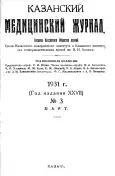К вопросу о феномене насильственного отведения глаз при паркинсонизме
- Авторы: Фридман А.П.
- Выпуск: Том 27, № 3 (1931)
- Страницы: 266-269
- Тип: Клиническая медицина
- URL: https://bakhtiniada.ru/kazanmedj/article/view/106726
- DOI: https://doi.org/10.17816/kazmj106726
- ID: 106726
Цитировать
Полный текст
Аннотация
Симптоматология хронической стадии энцефалита (resp. паркинсонизма) чрезвычайно разнообразна. Можно признать совершенно справедливыми слова Lhermith’a: „Эпидемический энцефалит обладает чрезвычайным полиморфизмом. Это болезнь, сбивающая с пути вариабильностью и богатством клинических проявлений“... Действительно, кроме известного для паркинсонизма и описанного впервые Economo 11 лет тому назад амиостатического симптомокомплекса (акинез-гиперкинез) и расстройств вегетативной нервной системы, обращали на себя внимание клиницистов различного рода симптомы со стороны отдельных черепно-мозговых нервов. Сюда относятся: редкое мигание (с. Stellwag), блефаро-спазм-клонус, расстройство зрения, двоение, сужение поля зрения, нарушение акта конвергенции и аккомодации при сохранности световой реакции—т. н. perverse Argyll-Robertson и проч. За последние 5—6 лет было также обращено много внимания на новый сопутствующий паркинсонизму симптом в виде насильственного отведения глазных яблок кверху, книзу, в стороны и, редко, вперед. Это насильственное содружественное движение глазных яблок в определенном направлении, наступающее периодически в виде припадков, немецкие авторы определяют словом «Schauanfälle».
Ключевые слова
Полный текст
Открыть статью на сайте журналаОб авторах
А. П. Фридман
Автор, ответственный за переписку.
Email: info@eco-vector.com
Россия, Ленинград
Список литературы
Дополнительные файлы





